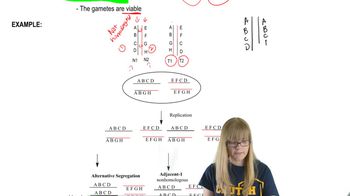When working on barley plants, two researchers independently identify a short-plant mutation and develop homozygous recessive lines of short plants. Careful measurements of the height of mutant short plants versus normal tall plants indicate that the two mutant lines have the same height. How would you determine if these two mutant lines carry mutation of the same gene or of different genes?
Table of contents
- 1. Introduction to Genetics51m
- 2. Mendel's Laws of Inheritance3h 37m
- 3. Extensions to Mendelian Inheritance2h 41m
- 4. Genetic Mapping and Linkage2h 28m
- 5. Genetics of Bacteria and Viruses1h 21m
- 6. Chromosomal Variation1h 48m
- 7. DNA and Chromosome Structure56m
- 8. DNA Replication1h 10m
- 9. Mitosis and Meiosis1h 34m
- 10. Transcription1h 0m
- 11. Translation58m
- 12. Gene Regulation in Prokaryotes1h 19m
- 13. Gene Regulation in Eukaryotes44m
- 14. Genetic Control of Development44m
- 15. Genomes and Genomics1h 50m
- 16. Transposable Elements47m
- 17. Mutation, Repair, and Recombination1h 6m
- 18. Molecular Genetic Tools19m
- 19. Cancer Genetics29m
- 20. Quantitative Genetics1h 26m
- 21. Population Genetics50m
- 22. Evolutionary Genetics29m
17. Mutation, Repair, and Recombination
Types of Mutations
Problem C.4b
Textbook Question
Explain the following processes involving chromosome mutations and cancer development.
How the chromosome mutation producing Burkitt lymphoma generates the disease.
 Verified step by step guidance
Verified step by step guidance1
Understand that Burkitt lymphoma is a type of cancer caused by a specific chromosomal mutation known as a translocation, which involves the exchange of genetic material between chromosomes.
Identify the chromosomes involved in Burkitt lymphoma, typically a translocation between chromosome 8 and chromosome 14, denoted as t(8;14).
Recognize that this translocation places the MYC gene from chromosome 8 next to the immunoglobulin heavy chain gene on chromosome 14, leading to overexpression of the MYC oncogene.
Explain that the overexpression of the MYC gene causes uncontrolled cell division and proliferation, which is a hallmark of cancer development, specifically leading to the formation of Burkitt lymphoma.
Summarize that the chromosomal mutation disrupts normal gene regulation, turning a proto-oncogene into an oncogene, thereby driving the malignant transformation of B cells in the lymphatic system.
 Verified video answer for a similar problem:
Verified video answer for a similar problem:This video solution was recommended by our tutors as helpful for the problem above
Video duration:
2mPlay a video:
Was this helpful?
Key Concepts
Here are the essential concepts you must grasp in order to answer the question correctly.
Chromosome Mutations
Chromosome mutations involve structural changes in chromosomes, such as translocations, deletions, or duplications. These alterations can disrupt gene function or regulation, potentially leading to abnormal cell behavior. Understanding these mutations is essential to grasp how genetic changes contribute to diseases like cancer.
Recommended video:
Guided course

Mutations and Phenotypes
Burkitt Lymphoma and Chromosomal Translocation
Burkitt lymphoma is caused by a specific chromosomal translocation, typically t(8;14), which moves the MYC oncogene next to the immunoglobulin heavy chain gene. This translocation leads to overexpression of MYC, a gene that promotes cell proliferation, driving uncontrolled growth of B cells and resulting in lymphoma.
Recommended video:
Guided course

Reciprocal Translocation
Oncogenes and Cancer Development
Oncogenes are mutated or abnormally expressed genes that drive cancer progression by promoting cell division and survival. When chromosome mutations activate oncogenes like MYC, they disrupt normal cell cycle control, leading to unchecked cell growth and tumor formation, as seen in cancers such as Burkitt lymphoma.
Recommended video:
Guided course

Cancer Mutations
Related Videos
Related Practice
Textbook Question
678
views


